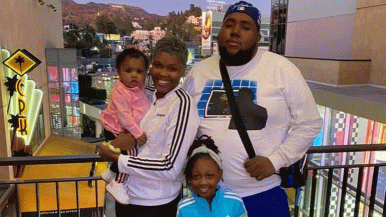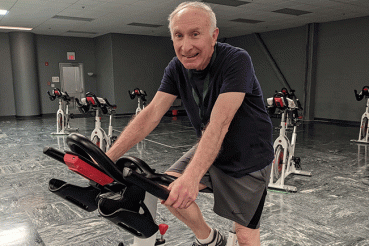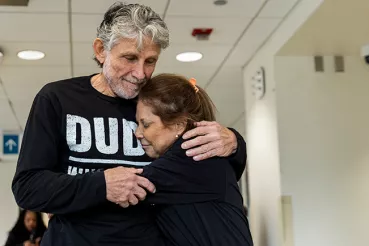At 23 years old, Reggie McMillian isn’t your typical advanced heart failure patient. The disease — caused by a weak heart that is unable to pump blood throughout the body — is most common in people age 65 or older with a history of high blood pressure or heart disease. For Reggie, his symptoms started in his teen years.
As early as 18 years old, Reggie started feeling tired, short of breath and unable to keep up with his friends when playing basketball. Eventually, he had trouble moving around, couldn’t lie down and had to sit up to sleep.
His grandmother recommended he visit John H. Stroger, Jr. Hospital of Cook County (formerly Cook County Hospital). It was there that Reggie received his diagnosis — heart failure — and met Setri Fugar, MD, a medical resident who would ultimately lead him to Rush University Medical Center.
At the time of his diagnosis, Reggie knew little about heart failure. A recent high school graduate, he was selling cars with his dad, who doesn’t have a history of heart issues. Reggie’s doctors started him on a medication treatment plan, and his symptoms improved.
After several years of treatment, however, Reggie’s health became inconsistent. He would feel sick for a while and then seem to recover. The ups and downs, and a particularly tough period of not feeling well, encouraged him to reach out to Fugar, who was now at Rush. Fugar connected Reggie to Rush’s team of cardiologists — specifically, Tisha Suboc, MD, and Karolina Marinescu, MD.
Worsening symptoms, a proven treatment
Suboc and Marinescu recognized that Reggie’s heart failure was advanced and required urgent intervention. They recommended a ventricular assist device, or VAD, to improve Reggie’s heart health and his quality of life.
A VAD is a mechanical device that helps a heart pump and circulate blood throughout a body. A surgeon connects the VAD to the heart, where it supports the heart by continuously taking blood from the ventricle and pumping it to either the lungs or the aorta.
Physicians recommend VADs for patients with advanced heart failure when other treatments, like medications, are no longer effective. The surgically implanted device can either be a temporary support until heart transplant or a long-term therapy, offering improved circulation and a reduction in heart failure symptoms. People often report feeling better shortly after surgery and having more energy.
Reggie and his girlfriend, Sheriden Bell, were surprised at this suggestion. They knew Reggie’s best long-term treatment option was a heart transplant, but they didn’t expect that he would need an additional heart surgery at the age of 22.
“Dr. Marinescu spent a lot of time breaking down my options and explaining the VAD to me,” says Reggie. Knowing that Reggie was in the car sales business, “she used car references to help me better understand what my needs were and what the procedure would do for me.”
Marinescu helped Reggie visualize his heart as an engine and his blood supply as fuel. With a weak engine (his heart), he wasn’t able to accelerate like other cars on the road. She described the VAD as an engine supplement — a device to allow his heart to keep up.
“For most patients, finding out their heart can no longer support their body is shocking,” says Marinescu. “Often, with advanced heart disease, we must move quickly toward treatment. I often use different analogies to help patients understand how their heart works and how their lives can be improved through our intervention.”
It takes a village: a team approach to VAD
With a diagnosis and a recommended treatment plan, Rush assembled a team of VAD experts to care for Reggie. This multidisciplinary team included Suboc and Marinescu, cardiovascular surgeon and VAD expert Antone Tatooles, MD, palliative care providers, VAD coordinators, specialized nurses and other health partners.
After further discussion, the team agreed that an LVAD — or left ventricular assist device — was the best treatment to bridge Reggie to a heart transplant.
Rush’s VAD program is part of the Medical Center’s nationally ranked cardiology and cardiac surgery program. It includes a team of advanced heart failure specialists committed to caring for people who are critically ill because of their heart health.
This group of cardiologists, cardiac surgeons and physician assistants, nurse practitioners and nurses provides input into patient care and recommends surgery only after exhausting conservative therapies. When a VAD is a patient’s best option, the team works together to not only ensure a successful surgery, but also a smooth recovery and transition to a better quality of life.
Sheriden appreciates how the team helped her and Reggie grasp both his condition and next steps. “We were really impressed with the doctors at Rush,” she says. “They made us feel included in decisions and made sure that we understood everything.”
“We start by understanding the patient as a whole,” says Tatooles, who implanted Reggie’s VAD. “We bring our knowledge of both the patient and the disease to our surgical therapy. We want to do things once, and we want to do them right. Every step is meaningful as we work to improve our patients’ lives.”
Reggie also credits his dad and grandmother for encouraging him to get the VAD implant and supporting his recovery.
After a hospital stay, a return to the everyday
For Reggie, both surgery and recovery went well. He received his VAD on December 16, 2019, and spent 29 days in recovery at the hospital.
“I had a great experience with my surgery,” says Reggie. “The hardest part was being in the hospital for so long. I felt good, and I was ready to go home and get back to my life.”
Reggie was able to return to many of his everyday activities, which now includes caring for his VAD. Reggie and Sheriden both learned how to take care of the VAD equipment, change the dressing around the cable, and ensure the pump is always connected to a power source.
Although the VAD works internally, a driveline runs from the pump to the abdomen area, where it is connected to a power source outside of the body. This driveline, which resembles a cable, is attached to a controller always connected to batteries or electricity.
To cover his VAD controller — the external component that controls the pump — Reggie got creative. As someone who loves fashion, he found stylish bags that hold his controller and disguise the device.
Partnering for long-term VAD care
Reggie is now fully independent, although he still has regular visits with his VAD coordinators.
A critical member of the Rush VAD team, VAD coordinators are physician assistants or nurse practitioners specially trained in heart health. They walk alongside a person receiving a VAD, educating them both before and after surgery about the device and what lifestyle changes to expect. VAD coordinators also monitor and support the health of their patients for their entire lives, or until heart transplant.
Melissa Manzuk, PA-C, manager of Rush’s mechanical circulatory assist device program, is one of Reggie’s VAD coordinators. She served as a cardiac surgery physician assistant for eight years before transitioning to her role as a VAD coordinator.
“We are a VAD patient’s ‘go to’ person if they need anything from a medical, health or social standpoint,” said Manzuk. “We know our patients inside and out. That’s one of the reasons I chose this field — because I enjoy having long-term relationships with my patients.”
Even after recovery, the VAD coordinator continues to report on the patient’s progress to their Rush care team and to bring in resources if needed. They also educate the patient on living with their VAD, including a few restrictions such as not being able to swim or submerge in water and avoiding metal detectors.
A family and a future
Reggie recovered quickly in part because of his outlook on life. Manzuk describes Reggie as “responsible and happy-go-lucky.”
“You could tell that he wanted to get back to living his life in the fullest way possible,” she adds.
For Reggie, that means a life full of work, travel and a growing family. He and Sheriden welcomed a daughter, Kaise, born just five months after his VAD implant. Reggie’s heart surgery means he can be a hands-on dad, not missing any of his active toddler’s milestones.
“When I went in for surgery, I was thinking about my daughter,” says Reggie. “I want to have the healthiest life possible for her.”
Reggie is teaching Kaise to not pull on the cable near daddy’s belly and is working to lose some additional weight so he can be added to the heart transplant waiting list.
“Sometimes I forget how big of a deal it is to have advanced heart failure and to wear a VAD,” says Reggie. “It’s just become part of my life, and I move forward.”




